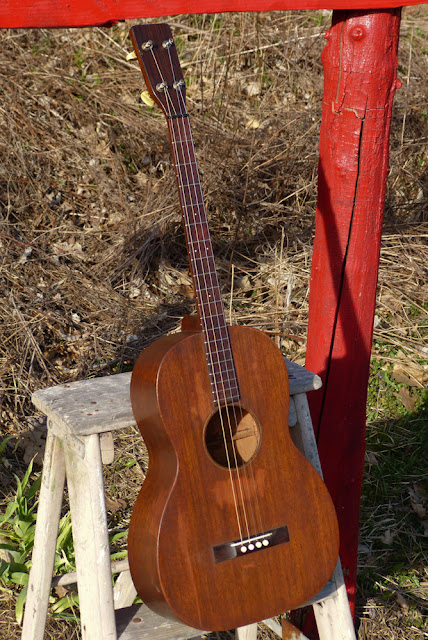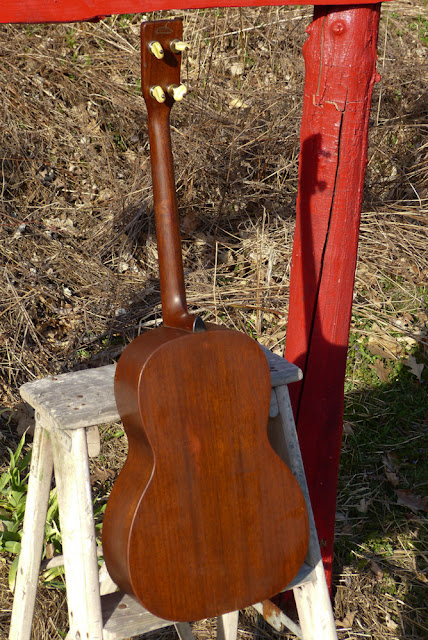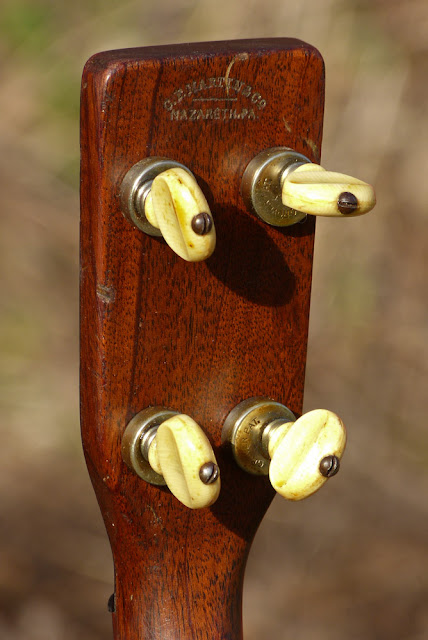1929 Martin 5-17T Flattop Tenor Guitar
When I first saw this guitar come in my immediate thought was: poor, poor, poor thing! It was covered in what can only be described as a "muddy wash" of thinned-down brown paint. Why? Who knows? To hide all the ramshackle old repairs? Yes, yes, probably. Still -- "action" was good as most of these old early 5-17Ts seem to come in with... though all the frets were certainly seated very poorly in the manner of railroad ties gone amok (I'm talking about you, Maumee). They're bar-frets, too, so they can be tiresome to get back down "just right" after the slots have either dried-out or loosened-up enough that the frets are slipping around (yes, this was the case, of course).
After much scrubbing I got the "milk paint" off of the body, for the most part, and could finally see all of the at-least-sturdy old hairline (and not-so-hairline, yowch) crack repairs and any that needed fixing (one back patch did). I then set to work on the frets, compensated the straight-slot saddle as well as I could, string-ramped behind the saddle, and filled/redrilled the pinholes so the strings would mount better. I also fished some suitable-looking plastic pins from the parts-bin.
The result is a beautifully rich-toned, full-sounding instrument that I was not expecting "judging by the cover." The owner had me string-it-up and tune it to BbFCG (a step down from "standard" CGDA) which makes it an easy instrument to play along horns and whatnot. This tuning was a pretty popular alternative to standard pitch on tenor banjos back in the 20s and 30s. I also like DAEB, too, but that suits short-scale instruments where one can put an 8 or 9 on top and manage to push it up to the B.
Remarkably, aside from the mucked-about finish, the only "unoriginal" bit on the guitar are the pins.
Nice pegs, huh? Ebony nut.
I've always liked the micro-dots on the style 17 instruments. These are ivoroid.
The board is Brazilian rosewood and the neck profile has a medium C profile.
No binding and a simple rosette are also things I find tasteful.
Note the weird lighter "discoloration" to parts of the finish after scrubbing. These were under the weird "milk paint" wash. I have no idea what was going on -- and there are still streaks of washy-style finish here and there on the instrument -- but I didn't want to go full-bore on the thing and possibly rub right through to the bare wood just to get rid of discoloration on what's -- let's face it -- and abused box.
I figured: if one could more-or-less see the mahogany that was a big bonus vs. a weird, flat-looking "drab brown."
What a hideous repair! It's stable, though. Not my work!
This cracked-up bit was sticking up when this came in. I pried it up a bit more, cleaned it up, and clamped the heck out of it until it fit decently enough to pass structural muster. Good... to... go. I had no inclination to disembowel all the old repairs to get it perfect.

















Comments
to buy from musikshack.com,an online musical instrument store.